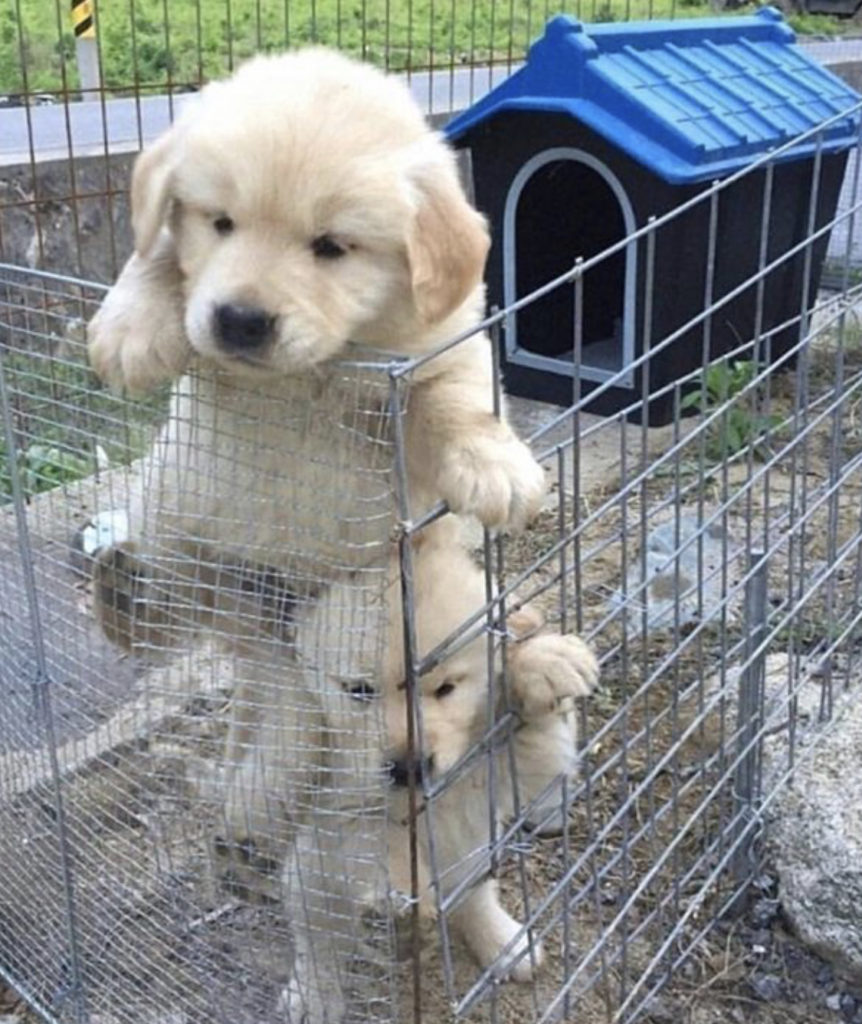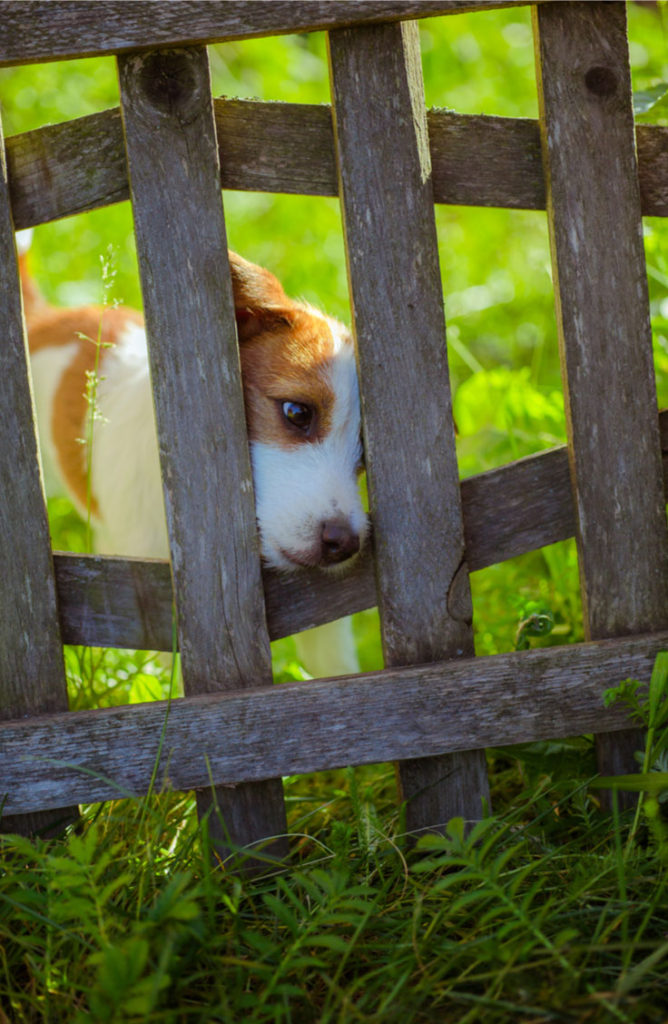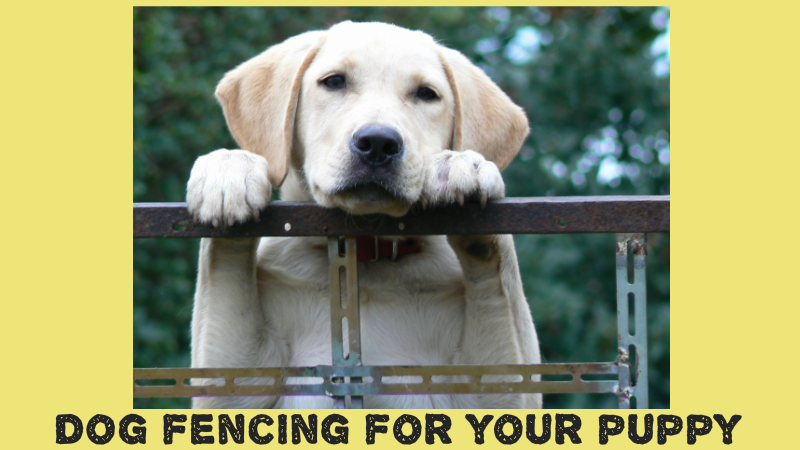Outside Puppy Fences
Dog Fencing for Your Puppy
This article will explain some of the best practices and some of the hints and tips for setting up dog fencing for your puppy.
We all love to see the joy that our puppies experience when being let loose in the yard, especially after being indoors for a while. At first, they will tentatively have a good sniff around and occasionally look back at you, just to make sure you don’t get too far away. Just remember, with a new puppy outside, you should always have a leash attached to a secure collar or harness.
As they become more familiar with these new outdoor surroundings, they will get braver and will start tugging at that leash or harness to investigate further.
Can’t I just train my dog to stay on the property without a security fence or leash?
This is a big error. Originally when your young puppy is brand-new, he will be brand-new to the outdoors. He will take a while to get used to the fact that he can mess around the backyard. Letting him loose without any protection is a dangerous choice. Your canine might not understand what his boundaries are and end up wandering off right into risk or being fatally hurt from traffic. You can prevent any problem by making sure you have adequate dog fencing for your puppy.
Safety and security are not the only concerns here. It is very difficult to educate a young puppy to remain within a particular area of land at such a young age. The range of different things to see and smell will be overpowering for a small puppy. His curiosity will be so great, he will be tempted to investigate everything. In fact, it is not uncommon for small puppies to wander off and get lost from situations just like this. And, once there is nobody looking after them, there is a great risk of injury or even death from a traffic accident or an interaction with a less than friendly dog.
Suburban Environments
If you live like most of us in a suburban environment, it won’t be long before that inquisitive little puppy is at the border of your property. Now, depending on where you live, you may or may not have a fence between your property and the next, or at the front of your property to keep any adventurous puppies from straying out into the road.
At this early stage, that innocent little puppy has no comprehension of what a property boundary is. In fact, this understanding will only really develop with specific training and patience on your part. To aid this development, you will need to provide some sort of confinement for your puppy. Depending on the breed of your puppy, it may take up to 6 months before he develops a working boundary awareness.
Questions to Consider While Choosing Your Enclosure Type
Unless you can spend every single minute with your puppy outside, and who wouldn’t love to do that, you will need to consider some type of dog fencing for your puppy. What type of enclosure you finally choose may depend on a number of things :
- How will your puppy manage this enclosure? You probably will have an insight to this from some of the house training you are trying. You will probably need to leave him alone in this outside enclosure at some stage. You Will this cause any stress, which may lead to long term behavior issues with your pet, or in the short term, an issue that may cause concerns with neighbors.
- What breed is your puppy? Will he grow into a large size dog, or is he a much smaller breed. This has a bearing on the type and size of any enclosure you have to consider. A large dog will need a larger area to be confined, and possibly a higher structure.
- Local regulations: Some neighborhoods do not allow fencing between one property and the next. If there are no fences in the street you live on, this may well be the case. You can check this out with your local town council or even chat with your neighbors.
Puppies are Expert Escapees
There is one thing to bear in mind after answering those three questions. It is a fact… Puppies have an innate sense of how best to escape from any given confinement. It could be from plain curiosity, or could even be from the worry of being left alone. It is amazing what puppies can do to escape. Just have a quick search on Youtube to see some of the amazing escapes.

Barriers Need to be Puppy Escape Proof
I mentioned earlier that for any barrier you consider, it needs to be suitable for the type of dog you have. Some dogs are capable of scaling high fences, even at an early age. Some other dog breeds tend to be “diggers”, and will attempt to dig under the barrier to get to the other side. If you choose a barrier that can be seen through, make sure that the holes or openings are not big enough for a puppy to squeeze through. Remember, a puppy can squeeze through a very small opening if he really puts his mind to it. So, you can see that you will need to put some thought into planning the dog fencing for your puppy.
Preventative Common Sense
Although it seems like preventative common sense, I have seen an entire fence go under construction and finished within a week’s time only to prove unstoppable for the owner’s puppies. The spacing was too wide! This simple detail in planning would have made all the difference in the world. Don’t let this person be you !
Choice of Enclosures
Basically, there are two types of enclosures to choose from. What you finally choose will either be some type of fenced enclosure or an electrical fence.
Pros and Cons of a Fenced Enclosure
Pros :
- Your dog will be able to roam free within the enclosure.
- Will protect your pet from what is outside the enclosure.
- Can be built to fit in with any landscaping you have in your yard or garden area.
- Plenty of styles available, either at your local hardware store, pet store or even online.
- Most will be able to be reconfigured or taken down to change locations.
- If an appropriate style is chosen for both your puppy and your location, you can relax. knowing that your puppy will be secure inside this enclosure.

Cons :
- You may be tempted to leave your pet outside for longer periods if you know the enclosure is secure.
- Possible stress or separation anxiety for your puppy when you first start using this enclosure.
- Depending on the style and area to be enclosed, cost may become an issue. If your enclosure is a larger size, you may even want to consider a tie out cable.
Electrical Fences
In those neighborhoods where fencing is not permitted, the use of an electrical fence to contain your puppy may be the only choice for any sort of outside confinement.
Check out this higher priced Electric Dog Fence Setup…
And here is another one for the more budget minded dog owner…
How Does an Electric Fence for Pets Work?
This system works much like a small scale radio station in your back yard. The transmitter will usually be set up somewhere in your garage or an outside room of the house and will broadcast a digital radio signal. An insulated cable connected to the transmitter is buried underground below where you choose your boundary to be. The receiver is a small device that is part of a dog collar, worn around your canine’s neck.
As your dog approaches this boundary area, there will be an audible alarm that will sound when the puppy approaches this boundary point.
If the puppy ignores that audible tone and continues to cross the boundary, a static correction is generated by the collar. This static correction (read small electric jolt) can be customized to suit your puppy or dog, ensuring it stays at the right level to maintain the appropriate deterrent. It is reported to be a completely safe and effective way to reinforce your pet’s boundary training.
Pros and Cons of an Electric Enclosure
Pros :
- Relatively easy to set up.
- Can be configured in a wide range of sizes and dimensions.
- Can be scaled up as your pet grows bigger.
- Will not hurt your pet.
Cons :
- Not suitable for puppies under 6 months old.
- Will not protect your pet from any animals intruding into the area.
- Relies on either a constant power supply or battery backup.
- Your pet will be able to see outside the area enclosed by the invisible barrier.
Puppy Fencing Wrap-up
I hope you have been able to learn something about dog fencing for your puppy. You can keep your puppy contained using either a fenced enclosure or an invisible electrical enclosure. There are many suppliers of both types, and if you need more detailed information, it is as simple as doing a quick search on Google, or even Amazon.

